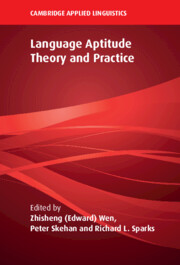Book contents
- Language Aptitude Theory and Practice
- The Cambridge Applied Linguistics Series
- Language Aptitude Theory and Practice
- Copyright page
- Contents
- Figures
- Tables
- Editors and Contributors
- Preface and Acknowledgments
- 1 Language Aptitude Research
- Part I Revisiting and Refining Aptitude Tests
- 2 The MLAT-Elementary
- 3 Testing Language Aptitude
- 4 The High-Level Language Aptitude Battery (Hi-LAB)
- 5 Exploring the Predictive Validity of the LLAMA (v1) Language Aptitude Tests
- Part II Aptitude Testing of Diverse Groups
- Part III Innovative Perspectives and Paradigms
- Part IV Aptitude–Treatment Interaction (ATI)
- Part V Final Commentaries
- Index
- References
4 - The High-Level Language Aptitude Battery (Hi-LAB)
Development, Validation, and Use
from Part I - Revisiting and Refining Aptitude Tests
Published online by Cambridge University Press: 27 May 2023
- Language Aptitude Theory and Practice
- The Cambridge Applied Linguistics Series
- Language Aptitude Theory and Practice
- Copyright page
- Contents
- Figures
- Tables
- Editors and Contributors
- Preface and Acknowledgments
- 1 Language Aptitude Research
- Part I Revisiting and Refining Aptitude Tests
- 2 The MLAT-Elementary
- 3 Testing Language Aptitude
- 4 The High-Level Language Aptitude Battery (Hi-LAB)
- 5 Exploring the Predictive Validity of the LLAMA (v1) Language Aptitude Tests
- Part II Aptitude Testing of Diverse Groups
- Part III Innovative Perspectives and Paradigms
- Part IV Aptitude–Treatment Interaction (ATI)
- Part V Final Commentaries
- Index
- References
Summary
The High-Level Language Aptitude Battery (Hi-LAB) measures the cognitive and perceptual abilities hypothesized to be important for adults to reach advanced levels of foreign language proficiency (Doughty, 2019; Doughty et al., 2010; Linck et al., 2013). This chapter will provide a historical overview of the Hi-LAB and its use, starting from the selection of constructs to measure, development of the battery, exploration of the battery’s measurement properties, and its use today. Over 15 years of work have been dedicated to selecting, refining, and validating the measures of the battery. We will explore how University of Maryland researchers as well as those of wider academia have used the battery to explore aspects of language aptitude, most notably, perhaps, the potential for Hi-LAB to inform language aptitude-by-treatment interventions. Potential directions for future work will also be discussed, pointing ahead to how the battery can continue to provide valuable aptitude information for language learning across populations, including language learners themselves, language instructors, academic researchers, and organizations who are interested in training personnel in new languages.
- Type
- Chapter
- Information
- Language Aptitude Theory and Practice , pp. 73 - 93Publisher: Cambridge University PressPrint publication year: 2023
References
- 1
- Cited by

